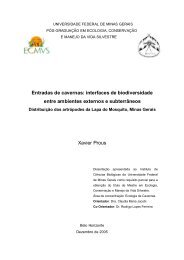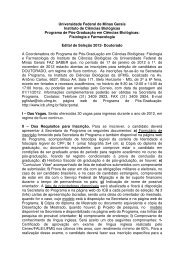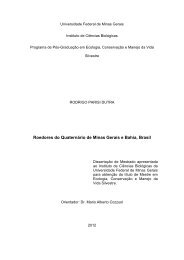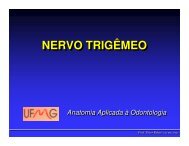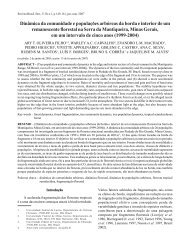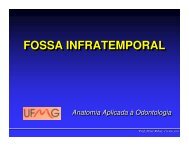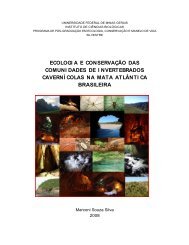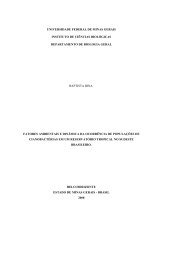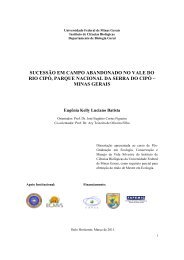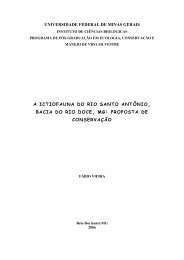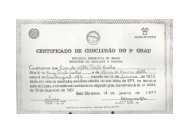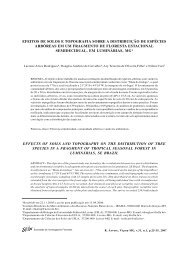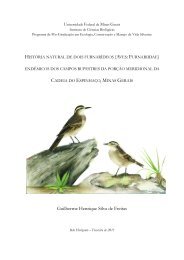universidade federal de minas gerais instituto de ciências biológicas ...
universidade federal de minas gerais instituto de ciências biológicas ...
universidade federal de minas gerais instituto de ciências biológicas ...
Create successful ePaper yourself
Turn your PDF publications into a flip-book with our unique Google optimized e-Paper software.
ABSTRACT<br />
Studies concerning benthic communities in reservoirs have received consi<strong>de</strong>rable attention<br />
due to the important participation of these organisms in ecological processes. The objective of<br />
this study was to assess the benthic macroinvertebrate communities (taxa compositiuon,<br />
structures and distribution) in two reservoirs in the Paraobeba River basin, a tributary from<br />
São Francisco River: Ibirité and Serra Azul. Samples were collected every two months during<br />
one year. The trophic level assessed in the Serra Azul reservoir presented a mean value lower<br />
than 44 in the rainy season (oligotrophic) and 45.1 in the dry season (mesotrophic). In the<br />
Ibirité reservoir, mean values higher than 54 were obtained in both seasons (eutrophic). Taxa<br />
richness ranged between 0 and 14 taxa in Ibirité and between 0 and 23 in Serra Azul. The<br />
higher richness values were found in the lotic sampling sites with higher granulometric<br />
diversity. The indicator taxa analysis showed that, during the rainy season, Chaoboridae<br />
(Diptera) was indicator in Serra Azul and Oligochaeta in Ibirité. Consi<strong>de</strong>ring the lotic<br />
sampling sites, there were no indicator taxa in both reservoirs in the rainy season. In the dry<br />
season, Hirudinea, Oligochaeta, and Chironomidae (Diptera) were indicators in Ibirité and<br />
Gomphidae (Odonata) in Serra Azul. In total, 54,512 organisms were collected, sorted and<br />
i<strong>de</strong>ntified. The most abundant taxa in the Ibirité reservoir were Oligichaeta (76.6%),<br />
Chironomidae (17.6%), Thiaridae (1.8%), Hirudinea (1.5%), and Chaoboridae (1.2%). In<br />
Serra Azul, Chironomidae (40%), Chaoboridae (22.7%), Oligochaeta (9.4%), Elmidae (8.4%),<br />
Baetidae (3.1%), Leptohyphidae (2.6%), Ceratopogonidae (2.4%), Leptophlebiidae (2.1%),<br />
Thiaridae (1.4%), and Sphaeridae (1.3%) were dominant. Comparing this study with available<br />
data from 5 years ago, in spite of the higher total <strong>de</strong>nsity of organisms (715,600<br />
individual/m 2 ) in the present study, taxa richness values achieved only 9 groups in the lotic<br />
sampling sites, presenting no significant differences from the previews study. The results<br />
showed a bad water quality in Ibirité and a better water quality, higher taxa richness and<br />
diversity values in Serra Azul. Reservoirs are responsible for several ecological modifications<br />
and studies assessing the benthic macroinvertebrates bioindicators of water quality contribute<br />
to the <strong>de</strong>velopment of conservation and management programs.<br />
Key-words: reservoirs, benthic macroinvertebrates, trophic level, lotic ecosystems.<br />
4



